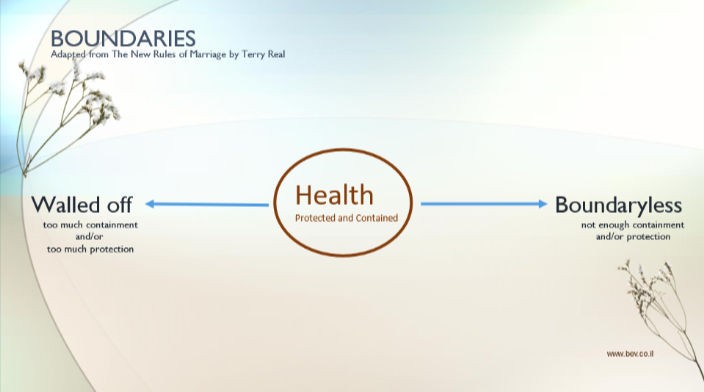Bev's Blog
Healthy Boundaries – Protected And Connected At The Same Time
"I am so shocked and my feelings so hurt that you would even think that of me!" If you're boundaryless and thin-skinned, you take in everything that's said to you. In a healthy relationship, you understand that other people think whatever they think about you. If it's not true, it's not true. It goes splat on the outside of your boundary; you don't take it in because it's not true. Why would you? You may care about what they're making up about you, but you don't let it in. It's about them, it's not about you.
In conversation keep listening and checking true, or not true. If it's true, relax your boundary and take it in. Then you can have your feelings about it.
Connected and Protected
Your physical boundary is about your body. People have different comfort levels about how close others can get to their bodies.
Your internal boundary is like your skin is to your body. It's where you end and the world begins. A good working internal or psychological boundary leaves you protected and connected at the same time. You're sifting through what's coming at you asking, "Is this true or not true?" If it's true, you relax your boundary and take it in. If it's not true, you keep it out. It's about them, it's not about you.
Two Functions
Through the work of Pia Mellody we understand that our psychological boundary has two parts to it. One part protects us while the other part contains us. Think of your psychological boundary like an orange rind. The white inside of the rind contains you and prevents you from leaking yourself all over the world, while the outer orange layer of the rind protects you.
- Protective: This part of the boundary protects you from the world. Nothing comes in unless you let it in. If it's true, take the information in, embrace it, and allow yourself to feel whatever you feel about it. If it isn't true, you don't let it in. It bounces off you. Terry Real gives the graphic metaphor of an egg that has been thrown at a windshield. It simply trickles down the glass with no impact on you. If you're not sure if it's true, you take time to sit with it and get some more information such as perhaps asking others for feedback and input.
- Containing: This part of the boundary protects the world from you. It stops you from being offensive and saying or doing things that should stay contained.
Walled-off or Boundaryless
If you are walled off, you're protected but you're not connected. You're not listening. You're not sifting through what's being thrown at you. You're just walled off. You're not taking it in at all. You're thick-skinned.
On the other hand, if you are boundaryless, there's no protection. You're connected but you're not protected. You're what we call thin-skinned. Your skin is too porous.
Circle of Health
In The Relational Brain workshop taught by Jules Shore, a healthy boundary is one in which you're protected and connected at the same time. With a healthy boundary, others can be different from you and you can still stay connected to them as well as to yourself. Because you have a good boundary, you're safe, because you have a good boundary, your partner is safe. It's ok with you that you see the world differently from each other. You don't have to take on your partner's truth to be connected. You don't have to ignore it and you don't have to close it off. When you're in health, you can hold differences pretty easily.
When you're out of health and boundaryless, you might lose thoughtfulness and the pause between what you think and what you do. You may need your partner to be ok for you. You may feel that you need to fix and make repairs quickly so that your partner can be loving and forgiving again. You need this specific response from your partner for you to feel ok again.
When you go walled off, you go into a shutdown space. You may move into a victim position where you feel that nothing you do will work anyway. You feel powerless and "trapped" as a client so clearly expressed herself to me. You're well protected but have no possibility for connection.
Create Your Boundary Exercise
Here's an exercise that Terry teaches that I like to use to help my clients create a healthier and stronger boundary. I recommend you record this on your phone and listen back as often as you need to.
Close your eyes and imagine a special place where you feel relaxed, happy, and comfortable. Now go there in your mind's eye. Feel what it's like to be there. Feel the air, smell the smell, hear the sound, feel the good feeling of being in that special place. Now, hold onto the good feelings of relaxation and pleasure, and come back to the room. Encircle yourself with, a barrier, something like a glass dome. It's impermeable and see-through. You can see out of it, and you're completely protected. You now have boundaries. Keeping your eyes closed, stay inside of it. This is what I want you to feel. Your boundary is impenetrable and you are protected. Nothing gets in unless you choose to soften your boundary and take it in. All you have to do is remember to put this shield up. Once it's up, it will protect you. Keep that boundary around you.
Coming to Closeness
With healthy boundaries, you are protected, connected, and appropriately contained at the same time. In other words, healthy boundaries bring us closer together.



